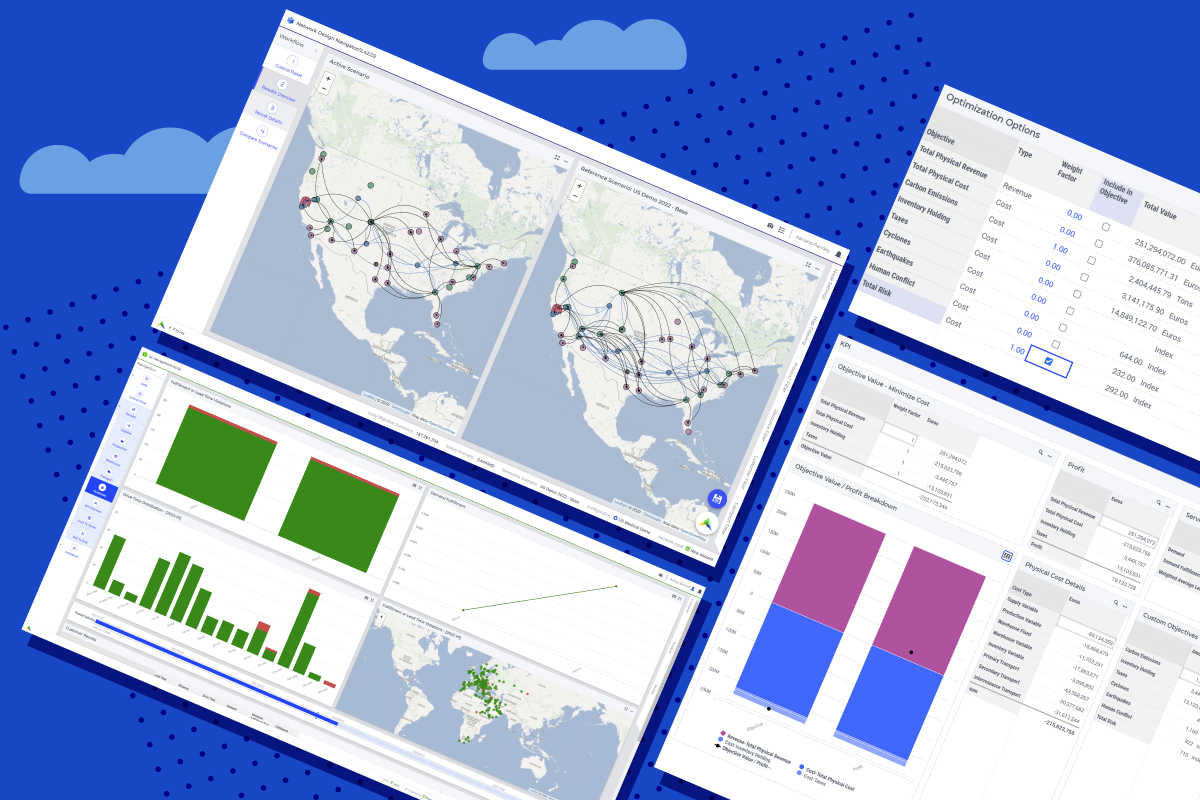Comparing Leading Supply Chain Network Design Software Vendors
It’s an exciting time in supply chain network design. Most organizations above $0.5B in revenue have been active in network optimization for some time, or are already considering how they will use technology to manage changes. Others are quickly realizing that there’s a lot of value in using powerful supply chain network design software.
The technology companies that support network design have also been experiencing much change.
Llamasoft was first bought by Coupa in 2020 and now Coupa has been acquired by Thoma Bravo, a leading private equity investor.
AnyLogistix is pursuing a path of stochastic simulation primarily.
AIMMS is growing rapidly with a combination of world-class optimization and scenario functionality, and innovative new delivery models.
We are hearing many questions from people who are looking at these supply chain network design technology vendors and evaluating options. So, we are offering insights below to help. Selecting the right technology partner shouldn’t be too difficult, given the differentiated positioning of these vendors:
- If ongoing ‘what if’ scenario modeling, coupled with leading mathematical optimization, is your cup of tea, join the AIMMS community.
- If you believe network design should be less strategic and more of an operational, execution tool, you should consider Llamasoft, particularly after their acquisition by Coupa and now Thoma Bravo.
- If you believe in stochastic simulation and think it’s the key to great network design, AnyLogistix is a good choice.
Why do AIMMS focus on scenario modeling and optimization, and not stochastic simulation?
Stochastic simulation represents your supply chain by stepping through time and taking variability in your data parameters into account. But it doesn’t really provide you with an optimum recommended action. Instead, it requires you to simulate or experiment with different outcomes, and then make a judgment as to which one is best.
For example, if you want to simulate how your truck queuing times change over a day, stochastic simulation would be a good solution choice. It doesn’t tell you what to do about it, but it does provide insights into how the queue fluctuates. Then, you can make some decisions about what to do using those insights.
AIMMS’ primary focus is optimization and scenario modeling, not stochastic simulation. This optimization-based approach is in our blood; we’ve been on the cutting edge for more than 30 years. We elect to compete in this space because when the user defines scenarios, (for example, a facility going offline while demand for a particular category skyrockets), our approach produces solutions that actually address the problem while optimizing revenue and margin goals. When you hit the optimize button, you get the optimal answer. It is prescriptive in nature, providing a recommended action.
Strategic network design and long-range capacity planning are great examples of use cases that are perfectly suited for optimization techniques.
Robust optimization combines the best of both worlds. It is a technique that can be used to provide optimum answers, but also solutions that are robust enough to deal with the variability in your parameters. This will be an area of focus for us in the future.
In short, simulation is great for understanding a multitude of possible events, while optimization focuses much more on the best possible actions during several scenarios.
Why does AIMMS focus on strategic network design, rather than network execution?
AIMMS customers do have large, operational execution solutions that run across thousands of nodes. Some of these have been ‘always on’ for more than a decade, but not in the network design space. We see network design as a strategic supply chain configuration tool. We like our clients to have a perpetually ready network design model, but you don’t need to make major network design decisions every day. You can’t build and open a new facility at a moment’s notice; it takes time to plan and implement.
Classifying network design as a strategic activity provides benefits over attempting to deploy it as an operational, execution system:
- Data can be brought into AIMMS from a variety of sources without having to wait for significant systems integration.
- Speed to value is weeks instead of quarters.
- The network design model is more agile, which is especially important in times of great change.
- Internal and external costs are significantly lower.
What about Digital Twin capabilities?
While a lot of vendors recently started claiming that they offer digital twin capabilities, the first digital twin built with AIMMS was delivered 15 years ago and it’s still operational today. We’ve been helping our customers do this for decades from a modeling perspective. AIMMS is, after all, a leading, flexible modeling tool.
It makes sense to represent your business as a digital twin and run scenarios on the digital representation before deploying in real life. Where things get tricky with the digital twin concept in network design is the level of granularity that is monitored.
For example, a production machine may have telematics to measure critical speeds, temperatures, wear patterns, input, and output. This is valuable information, and excellent vendors will embed this information in a digital twin. The only question is, what has this got to do with network design? Are you really going to configure the location of a new facility and available transportation modes based on the temperature of a production asset?
Yes, we do believe in the concept of the digital twin but only at the appropriate level of aggregation and deployed as a perpetually ready model (digital representation) of your business that supports solid strategic decision-making.
What about network design delivery models?
Shopping for a vendor is the easy part, but how are you going to deliver network design benefits for your business?
With AIMMS, you can implement network design your way. We work with a diverse range of industries and business sizes and have found that customers are most successful by selecting one or a hybrid of the following delivery models:
- For customers who want network design “delivered on a plate,” it’s best to work with a consulting partner in our ecosystem who has extensive experience in that area.
- For customers that have a modest-sized network design team or only functional skills, AIMMS offers a network design-as-a-service solution. This offering takes the background work (for instance, data cleansing and configuration) away from the customer, so they can focus on strategic scenario modeling and are empowered to make great decisions while investing only 100 hours per year. We see this approach multiplying.
- For customers who want to build this capability in-house with their team, AIMMS offers onboarding, training, and support services.
Find out which supply chain network design capability is the best fit for your company and team with this free assessment.
What about functionality?
A few years ago, Llamasoft was the clear market leader in network design functionality. They spent decades building functionality into their app, either by developing it themselves or by acquiring other vendors.
While AIMMS has been in the network design business for decades, we’ve only offered an off-the-shelf application for 6 years. Yet, we often win in competitive situations. How do we punch over our weight class? Having been around for over 30 years, we’ve invested more than a million hours into building the best supply chain modeling platform in the business.
We use our modeling platform and can build and deploy network design functionality an order of magnitude faster and more efficiently.
Our technology is more agile. It adapts to changes in market conditions fast and carries far less redundant functionality, so it’s easier to maintain. It took us only a few years to catch up, imagine where we will be in another couple of years.
I hope this article is helpful if you’re evaluating your options for network design. For more insights into how AIMMS can support your supply chain operations, feel free to contact us for a personalized demo.






you give no indication of price. I imagine XCARGO is less expensive than AIMSS. Am I right. Thanks for giving an idea of price for these software licences or use in SaaS
Hi Jean, thank you for your interest in AIMMS. While I can understand your curiosity about the pricing of XCARGO and how it compares to AIMMS, I’d like to clarify a few points. It’s important to note that XCARGO and AIMMS are distinct software applications designed for different purposes. Both tools serve different functions and are not directly comparable.
About pricing, software licenses or SaaS subscriptions can vary widely depending on several factors. I recommend filling out a demo form – https://www.aimms.com/get-a-demo and letting our sales team provide you with pricing information based on your specific needs and circumstances.
I hope this helps!